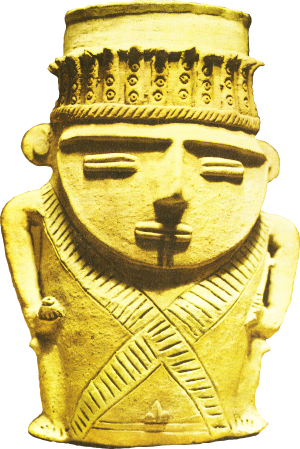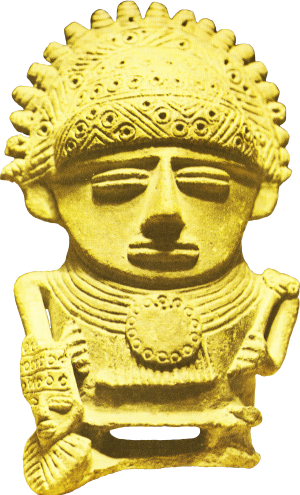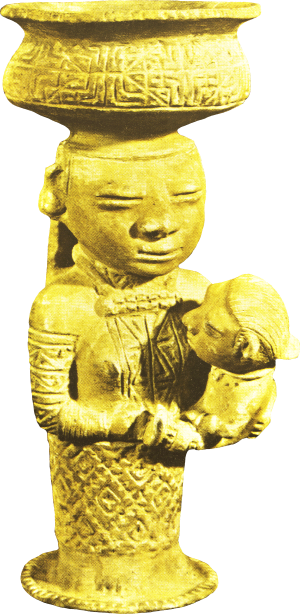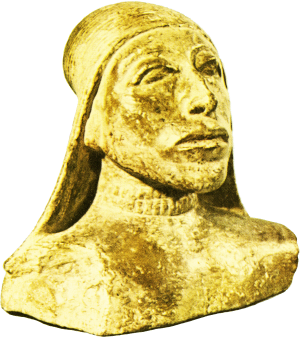

The Motilone (Barí) Miracle
A Christian missionary to be proud of...
By Faith Annette Sand
Normal noises filled the jungle afternoon—cicadas beginning to announce that evening wasn't far off, birds singing then sweeping over the river in pursuit of fish attracted by lazy flies. The monkeys were out of eyesight, but you could hear them chattering in the tall trees just beyond the clearing.
The changing of the guard from diurnal crew to nocturnal gang was definitely underway when the putt-putt of a motor broke through the idyllic green. I turned to Jairo, my fifteen-year-old Motilone guide, and asked, “Does that sound like the Iquiacarora boat coming upstream?” He thought it did.
I hurried to the river landing and watched the long dugout round the bend and get larger on the horizon. As it approached, I saw one blond head—the head of the person I was looking for—seated amidst a dozen black-haired people. I waved at the boat as it came alongside the landing, and the Motilone pilot deftly turned the canoe towards the shore.
Bruce Olson had been a hard person to find. After flying over the Andes to Cúcuta, a town in northern Colombia on the Venezuelan border, I had boarded one of those buses where suitcases are loaded on top while pigs and chickens come inside with their owners. We bumped five hours over washboard roads before arriving in Tibú, an oil town whose dusty streets are slicked down with a refinery by-product. (It keeps the dust from flying—but makes every step a trifle precarious.)
In Tibú, the Motilones maintain a large house where any tribal member can stay while being treated at the oil company's hospital. I had been telephoning this house for days, trying to get some information on Bruce's whereabouts. Each time, however, I had found myself speaking Spanish to a woman who understood only Motilone.
Finally, hoping to do better with sign language, I decided to make the trip to Tibú anyway. And to my relief, when the Motilone woman came to the gate, she smiled broadly—and went to call Jairo, a bilingual high school student who had just arrived from the jungles.
Jairo not only spoke good Spanish; he knew Bruce's itinerary. Best of all, he was willing to guide me to where he thought we could intercept Bruce the next day. I would find him on the river, said Jairo, making his circuit, visiting the villages, tending the sick.
Unfortunately, the pickup I needed to ride in for the next leg of the trip made only one trip a day—at six in the morning. Bright and early, Jairo and I crowded into the back end of the '42 Ford, which featured a plank down each side for first-class seating. (The unlucky hung on behind or dangled off the running board.)
The road followed an oil pipeline, which headed into the interior in a pretty straight line, up and down very hilly terrain. The Andes were nowhere in sight, but it was easy to see that we were on their tropical foothills.
After a breezy four-and-a-half-hour ride, we came to the River of Gold (named by some hopeful explorer). There we hired a Colombian boat to take us upriver another two and a half hours, where we were dropped at the home of a Motilone. It was there, in that idyllic jungle setting, that I waited to see how accurate the jungle telegraph really was.
As Bruce stepped out of the dugout to shack my hands, I felt like an accomplished scout who had just flushed a long-sought prize from its jungle habitat. I wanted to say, “Dr. Livingston, I presume?”—but I wasn't sure he'd understand.
The disparity between Bruce's tall Nordic frame, and the short, sturdy indigenous Motilones was the first thing I noticed. Yet his ease in communication with them and their naturalness with him somehow made him fit into their world.
“You feel like a Motilone to me,” I said as we walked toward the house.
“I will never really be a Motilone,” he answered. “I will always be different from them. Yet I know I will never again feel fully comfortable in the culture where I was raised.”
After having spent eighteen years in Latin America, I could relate to these feelings. To become a missionary is to give up not only the homeland but also the feeling of belonging in the homeland.
And the Motilone are certainly an admirable people to give yourself to. They are calm, soft-spoken, curious, and exceptionally gentle with their children. They are also generous and pleasingly content with their rather primitive existence. Bruce, I found, had taken on many of these Motilone characteristics in the two decades he had lived with them.
After that first meeting, we talked for nine hours nonstop. We talked through supper, through a one-and-a-half-hour boat ride to Iquiacarora, and for many hours after. Sitting in front of a clinic he helped establish, watching the full moon make its way across the sky, Bruce told me the story of how he came to work with the Motilone tribe.
Later he invited me to accompany him for a few days as he made his rounds, to give me a better feel for the Motilones and their world. I eagerly accepted, wanting to see for myself the amazing success this dedicated Christian missionary has had in helping to preserve the Motilones' traditional lifestyle while assisting them in a rather traumatic transition into the modern age.
The next day, Bruce and I waded through streams and squished along muddy jungle trails. Exotic vines dangled in our path, with thousands of varieties of orchids and flowers painting a serene beauty.
Yet in the midst of this beauty came the loud cries of tropical birds and screeching monkeys. Each of these creatures seemed to protest harshly our invasion of its turf.
As we plunged deeper into the Motilones' traditional land, I couldn't help but reflect on how much like the birds and animals of the jungle these indigenous people are. Living in amazing harmony with their tropical environment, they have been for four hundred and fifty years a territorial people. Following the laws of the jungle, they have done all in their power to keep foreigners off their turf.
Spanish conquistadores, dreaming of fabulous gold mines, made a mule trail through Motilone territory and established a settlement as a local power base. The ruins of a sixteenth-century Spanish chapel are still extant—a silent witness to how the cross accompanied the sword into the New World. (European churches are still filled with gold objects sacked from the indigenous peoples of Latin America.)
That the Motilones refused to be plundered is a testimony to their own feelings of self-worth. The Spaniards who settled in the Catatumbo River valley—which funnels water from the Andes down to oil-rich Lake Maracaibo—never made it back to Spain. They were massacred as they caravanned back to the coast. The gold bullion which they dropped has been swallowed by centuries of jungle growth.
The lesson of the Spanish invaders was never forgotten by the Motilones. They began killing everyone from the murderous and stealing “white” race who invaded their territory.
Until Bruce Olson.
It still isn't clear to them why they spared the life of this young Minnesotan who felt the so-called-of-God to bring them the message of Christ. Indeed, they shot him in the leg with an arrow when he first ventured onto their lands. But as a tall, gangly, blond youth, he didn't look much like a normal oil prospector or a Colombian land poacher. And he had a strong body which didn't succumb to the fever and infection which set in his leg.
Perhaps it was all part of God's providential care for the Motilone. Perhaps God knew that the tribe was reaching the end of its ability to fend off the invader. Their homeland was surrounded by Western oil companies, mineral prospectors, and land developers. People in the area remember how planes from the “outside world” firebombed the traditional Motilone longhouses, trying to force the Motilones to move off their oil-rich land. Remaining isolated and protected from the greedy outside world was no longer possible.
The Motilones, despite their cannibalistic reputation, are people who, at least in their exotic jungle environment, largely live at peace with each other. During his [thirty-eight] years with the tribe, Bruce has seen little homicide, drunkenness, prostitution, or physical violence. Not only do they have a true sense of belonging to one another in the community, but they also immensely enjoy life together in their habitat. Everything they do is made into a sport. Hunting, weaving, fishing, grinding, collecting the earth's produce—all of these become part of their happy modus vivendi.
That first morning, for example, Bruce and I joined a group of Motilone on a nearby river. The early birds had enclosed a U-section of the river with a stone dam reinforced with broad leaves that looked like banana leaves, but much stronger. This gradually dropped the water level in the U, exposing the fish. The fish were speared with long, thin shafts which the Motilones sharpened after each thrust with knives held in their teeth. After a couple of hours, some men had fifty or sixty fish strung on their vines which they trailed in the cool water.
The day took on the feeling of a Fourth of July picnic. Children happily grubbed crabs under the rocks along the mud banks. Women collected and wrapped the fish in broad leaves for carrying home. And the men competed fiercely.
The celebration fervor seemed complete when the men decided to line up along the jungle trail—old men at the front on a handicap basis for a foot race home. (Chieftains in the tribe usually are the best hunters, fishers, and runners!)
During the dry season, these fishing expeditions occur three or four times a week. During the rainy season, the Motilones hunt with the same intensity. Incredible to think that every day is made into such a lark!
That day's fishing expedition, however, was marred somewhat, when a nine-year-old boy got too close to someone wielding a knife and was gashed in the leg. A sturdy young warrior carried the by piggyback to the clinic at Iquiacarora, where Bruce deftly put nine stitches in his leg.
“How do you account for all the skills you've managed to acquire without standard credentials?” I asked. “You've hardly even been to a university.”














